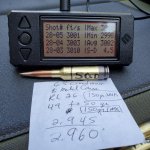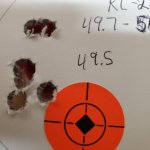Hi all,
I'm a novice reloader and I've been trying to get some handloads for 6.5 CM to be at least as good as the Hornady 140gr ELDM box ammo I shoot. Generally I'm getting SDs around 14-20, ESs around 51-66, but I've been told single digit SDs and ES under 20 is the standard. Here's the rundown of my gear and process:
How would you change my process for the best improvement to SD/ES/precision without going absolutely crazy on gear cost? I have some budget, but $700 for powder scales, etc is probably not in the cards for me unless I go all the way into the deep end with this hobby. Some suggestions I've heard from friends are:
I'm a novice reloader and I've been trying to get some handloads for 6.5 CM to be at least as good as the Hornady 140gr ELDM box ammo I shoot. Generally I'm getting SDs around 14-20, ESs around 51-66, but I've been told single digit SDs and ES under 20 is the standard. Here's the rundown of my gear and process:
- Using pretty much all once-fired Hornady brass from my ELDM box ammo
- I deprime the dirty brass with a Lee depriming die, then lube and size in a RCBS MatchMaster FL die, then tumble in my Frankford Arsenal tumbler with just dish soap. My brass doesn't get very dirty since I shoot on concrete and I'm trying to save the annoyance of collecting steel pins; I've read that sizing brass before cleaning may wear out the dies faster, but again, if it's not filthy is that an issue? Otherwise, would you tumble,size, then tumble again to get rid of the grease?
- I prime with a Frankford Arsenal hand primer, which I find is faster than my press' built-in priming widget. Using Remington 9 1/2 LRPs.
- I have a Lee perfect powder measure, a trickler and a Hornady digital powder scale. I typically charge the case (H4350) by putting the case on the scale, zeroing it, throw a powder load, and then trickle up to the exact grain of powder that gets the scale to tick over to the correct tenth-grain I want. This is pretty tedious, and I've debated whether just using the powder measure is good enough, regardless of where in the "tenth" it lands.
- Then I seat the bullet. I've used almost exclusively Hornady 140 ELDMs. I intend to branch out to others but first I figure my process is the main issue over the projectile selection.
How would you change my process for the best improvement to SD/ES/precision without going absolutely crazy on gear cost? I have some budget, but $700 for powder scales, etc is probably not in the cards for me unless I go all the way into the deep end with this hobby. Some suggestions I've heard from friends are:
- Switch to SRP Lapua brass and don't use Hornady brass at all
- Experiment more with other projectiles
- Get new dies instead of FL dies - I guess neck sizing/shoulder bump is preferable?
- Get a case trimmer setup
- Get an annealer
- Experiment more with seating depth - note, I haven't done much experimentation here at all
- Try different primers (LRP)





